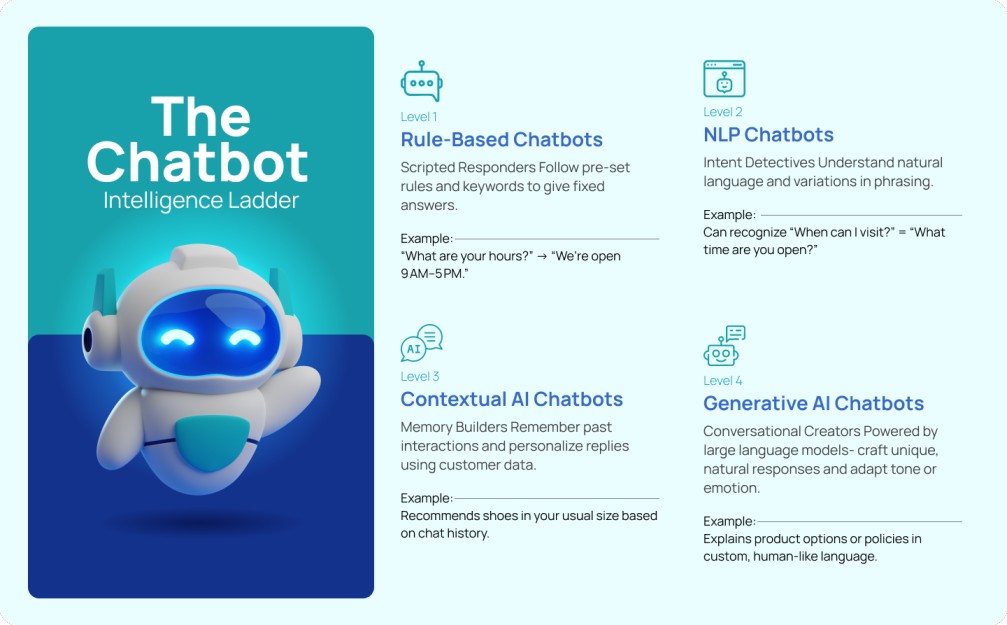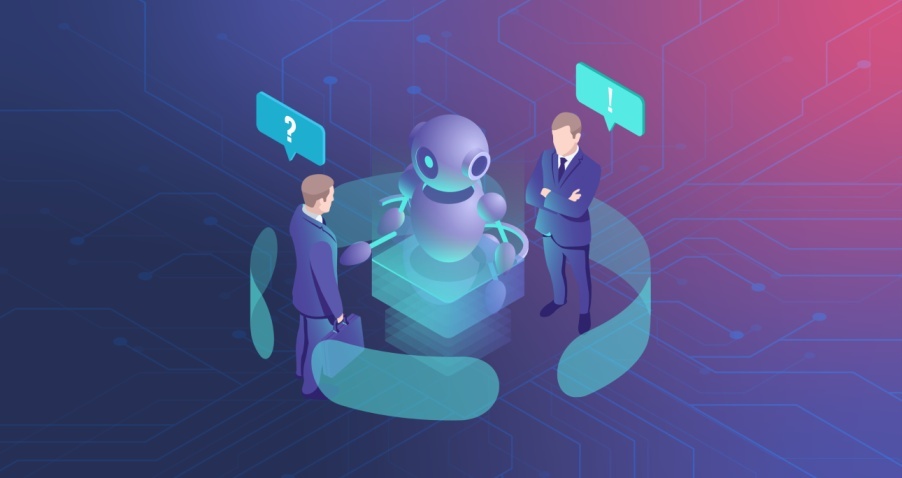A New Era of Conversations
Customer expectations are higher than ever. People want instant answers, personalized support, and meaningful interactions every time they reach out to a brand. Traditional customer service systems often struggle to keep up with this pace, but AI chatbots can.
In fact, integrating chatbots into your broader content marketing strategy is already becoming a must for future‑ready brands. If you’re planning your growth strategy for next year, check out our guide on building a 2026 content marketing plan to see how automation and personalization fit together. These insights will help you understand how chatbots can align with a long‑term customer‑experience plan.
Studies predict that around 95% of customer interactions will involve some form of AI by 2025. These chatbots are not replacing humans but making communication faster, easier, and more personal. As one of the key tools in AI customer engagement, they help businesses stay available all day, assist with queries, and personalize every interaction through smart chatbot automation. At Inbounderz, we see them as proof of how AI chatbots improve customer engagement, a modern link between technology and human connection.
From Scripts to Smart Conversations: How AI Chatbots Really Think
The earliest chatbots worked from fixed scripts. They could respond only to certain keywords, which made them sound basic and mechanical. Today’s chatbots use conversational AI powered by natural language processing and machine learning. They understand intent, context, and tone well enough to hold meaningful chats that feel natural to customers, and they are already proving how AI chatbots improve customer engagement through fast, friendly, and personalized support.
You can picture this evolution as a Chatbot Intelligence Ladder with four levels:
- Rule‑Based Chatbots: Respond only to pre‑set questions.
- NLP Chatbots: Recognize natural phrasing and language variations.
- Contextual AI Chatbots: Remember past conversations and personalize responses.
- Generative AI Chatbots: Use large language models to create human‑like responses and adapt tone.

Each level makes the chatbot more intuitive and improves overall customer satisfaction.
Instant, Intelligent, and Always On: Why Chatbots Win on Experience
AI chatbots for customer service never take a break. They handle questions anytime, across platforms like websites, WhatsApp, Instagram, or Messenger. Through smart chatbot automation, they learn from every interaction, which helps them tailor replies using each customer’s history or preferences. This constant learning is one of the key benefits of AI chatbots for personalization, turning every response into a more thoughtful and relevant experience.
Imagine a returning visitor to your website who’s been checking a specific service. The chatbot greets them with, “Welcome back! Want a quick look at our latest offers?” That kind of small but smart touch keeps customers interested and makes them feel noticed while freeing up your team to handle complex requests.
Proof That Works: Real Data from Real Brands
These real‑world examples of AI chatbots in business highlight measurable success across beauty, food, and banking.
- Sephora – Personalized Guidance That Drives Sales
Sephora uses its chatbot across channels like Facebook Messenger and Kik to provide personalized makeup tips, tutorials, and product matches. The Sephora Assistant recommends products based on style preferences and even directs users to in‑store appointments. According to Chatbot Guide, this simple conversational tool reduced appointment‑booking time from five minutes to one, while driving measurable increases in store traffic and product sales. Customers who interacted with the bot were significantly more likely to complete purchases because the experience felt personal and effortless. - Domino’s – Making Ordering as Easy as Talking to a Friend
Pizza delivery giant Domino’s built an AI‑powered assistant that lets customers order through chat or voice without touching the app. The company’s 2025 update, reported by Business Insider, notes that Domino’s new generative AI bot adds personality and natural conversation flow to make digital ordering feel human. This assistant now manages a large share of online orders, providing faster confirmations and fewer input errors. Domino’s AI system also remembers frequent orders, saving time and improving convenience for repeat customers. - HDFC Bank – Scaling Service for Millions with Eva
India’s HDFC Bank developed Eva (Electronic Virtual Assistant), one of the country’s largest AI‑driven banking bots. As detailed in Analytics Vidhya’s 2025 case study, Eva responds to more than five million customer queries per month across products and services. Built with natural‑language processing, it answers over 5,000 questions about savings, loans, and credit cards in English and Hindi. Eva has cut down average response times from minutes to seconds, reduced dependency on call‑center staff, and improved accessibility for customers across different time zones.Together, these examples show how brands are using AI chatbots to reduce friction, save time, and keep customers engaged. Whether it’s personalized beauty guidance, fast food orders, or instant banking support, the results are the same — better experiences and stronger trust.
Beyond Support: How Chatbots Drive Engagement and Retention
Chatbots have evolved far beyond their early role in customer support. Today, they play a key role in AI customer engagement, helping businesses build stronger relationships through smart chatbot automation. They assist with marketing and retention by capturing leads, collecting feedback, and recommending content or products that match individual preferences. These improvements show clearly how AI chatbots improve customer engagement across every stage of the customer journey.
Chatbots also enhance campaigns by following up with people who click your ads or visit landing pages by creating a continuous, connected experience. This can significantly strengthen ad performance over time. To explore more ideas on using AI tools in advertising, read our article on boosting your Google Ads ROI with smart AI strategies.
To visualize how chatbots support the entire customer journey, imagine this Chatbot‑Led Customer Journey Loop:
Attract → Engage → Convert → Retain → Re‑Engage
- Attract: Chatbots greet visitors and offer help.
- Engage: They personalize replies, making information relevant.
- Convert: They guide customers to sign up, book, or buy.
- Retain: They follow up after purchase and check satisfaction.
- Re‑Engage: They bring users back with reminders or offers.

Chatbots help brands maintain communication and relationships long after the initial sale.
Human + AI Symbiosis: Getting the Balance Right
The best results come when humans and AI complement each other. Chatbots can handle repetitive questions and quick updates, while humans deal with emotional or complex issues.
Think of it like a relay team: chatbots keep the flow moving fast, and humans step in where empathy or judgment matters most. For instance, a chatbot could resolve basic billing queries and pass sensitive complaints directly to a support specialist.
AI Handles: scheduling, FAQs, order tracking, simple troubleshooting
Humans Handle: empathy, advanced problem solving, relationship building
The Challenges That Make or Break Chatbot Success
Even advanced tools can struggle. Understanding the challenges of AI chatbots in customer services like tone and privacy can make or break customer trust:
- Over‑automation: When users can’t reach a human easily, frustration increases.
- Inconsistent tone: A robotic or mismatched voice can hurt brand perception.
- Data privacy: Customers need to trust that their conversations are secure.
A balance between automation and human oversight is essential. Make sure your website encourages smooth transitions from chatbot to human support whenever needed. Small improvements in navigation and structure also boost chatbot success. For practical tips, take a look at our guide on common website mistakes to fix right now.
What’s Next: Voice, Emotion, and Predictive Conversations
The future of AI chatbots in 2025 and beyond will focus on deeper emotional awareness and predictive engagement powered by the Generative AI chatbot. Some are like;
- Voice‑enabled assistants with natural spoken interaction.
- Emotion‑aware chatbots that recognize a customer’s mood.
- Predictive AI that anticipates user needs before they are expressed.
Generative AI technologies are making this possible by helping bots craft customized answers in real time. These developments mean that chatbots will soon become true “digital associates,” supporting marketing, service, and even brand storytelling all at once.
How to Implement Chatbots Strategically
If you’re considering adding a chatbot to your business, start with a simple plan:
- Set clear goals. Identify what you want the chatbot to achieve- support, sales, or lead capture.
- Choose the right platform. Solutions like Dialogflow, Intercom, and ManyChat work well for most industries.
- Train it well. Use real customer questions and align responses with your brand tone.
- Measure and improve. Track engagement rates, satisfaction, and conversions.
- Scale thoughtfully. Optimize before expanding to new channels.
As you do, make sure your chatbot feels like part of your brand personality. Every word it uses represents your voice. If you’re still shaping how your business speaks, take a moment to read our guide on building a memorable brand identity from scratch. It shows how to create a consistent brand tone that makes your chatbot truly sound like you.
The Future Belongs to Smart Conversations
AI chatbots are changing how businesses communicate. They do more than just answer questions, they create ongoing relationships that make every customer feel valued.
By blending automated efficiency with a human touch, brands can deliver faster responses, save time, and improve satisfaction. Businesses investing in the best AI chatbots for customer engagement will stay ahead, offering personalized, seamless conversations that customers actually enjoy.
Ready to make your brand more responsive and human at the same time?
Get in touch with Inbounderz to explore how AI‑driven customer engagement can grow your business.



